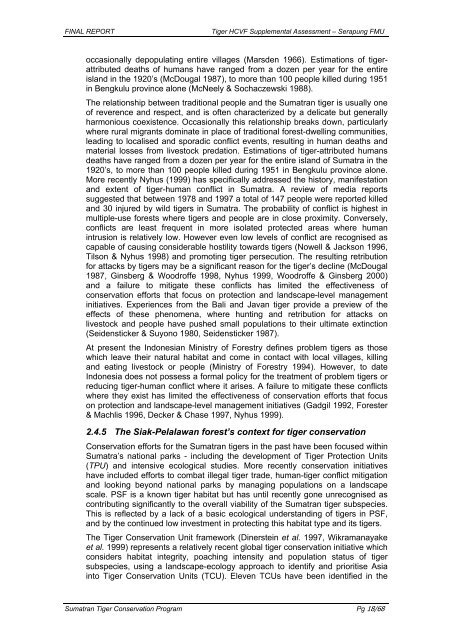A Supplemental HCVF Assessment on the Sumatran Tiger ...
A Supplemental HCVF Assessment on the Sumatran Tiger ...
A Supplemental HCVF Assessment on the Sumatran Tiger ...
You also want an ePaper? Increase the reach of your titles
YUMPU automatically turns print PDFs into web optimized ePapers that Google loves.
FINAL REPORT <strong>Tiger</strong> <str<strong>on</strong>g>HCVF</str<strong>on</strong>g> <str<strong>on</strong>g>Supplemental</str<strong>on</strong>g> <str<strong>on</strong>g>Assessment</str<strong>on</strong>g> – Serapung FMU<br />
occasi<strong>on</strong>ally depopulating entire villages (Marsden 1966). Estimati<strong>on</strong>s of tigerattributed<br />
deaths of humans have ranged from a dozen per year for <strong>the</strong> entire<br />
island in <strong>the</strong> 1920’s (McDougal 1987), to more than 100 people killed during 1951<br />
in Bengkulu province al<strong>on</strong>e (McNeely & Sochaczewski 1988).<br />
The relati<strong>on</strong>ship between traditi<strong>on</strong>al people and <strong>the</strong> <strong>Sumatran</strong> tiger is usually <strong>on</strong>e<br />
of reverence and respect, and is often characterized by a delicate but generally<br />
harm<strong>on</strong>ious coexistence. Occasi<strong>on</strong>ally this relati<strong>on</strong>ship breaks down, particularly<br />
where rural migrants dominate in place of traditi<strong>on</strong>al forest-dwelling communities,<br />
leading to localised and sporadic c<strong>on</strong>flict events, resulting in human deaths and<br />
material losses from livestock predati<strong>on</strong>. Estimati<strong>on</strong>s of tiger-attributed humans<br />
deaths have ranged from a dozen per year for <strong>the</strong> entire island of Sumatra in <strong>the</strong><br />
1920’s, to more than 100 people killed during 1951 in Bengkulu province al<strong>on</strong>e.<br />
More recently Nyhus (1999) has specifically addressed <strong>the</strong> history, manifestati<strong>on</strong><br />
and extent of tiger-human c<strong>on</strong>flict in Sumatra. A review of media reports<br />
suggested that between 1978 and 1997 a total of 147 people were reported killed<br />
and 30 injured by wild tigers in Sumatra. The probability of c<strong>on</strong>flict is highest in<br />
multiple-use forests where tigers and people are in close proximity. C<strong>on</strong>versely,<br />
c<strong>on</strong>flicts are least frequent in more isolated protected areas where human<br />
intrusi<strong>on</strong> is relatively low. However even low levels of c<strong>on</strong>flict are recognised as<br />
capable of causing c<strong>on</strong>siderable hostility towards tigers (Nowell & Jacks<strong>on</strong> 1996,<br />
Tils<strong>on</strong> & Nyhus 1998) and promoting tiger persecuti<strong>on</strong>. The resulting retributi<strong>on</strong><br />
for attacks by tigers may be a significant reas<strong>on</strong> for <strong>the</strong> tiger’s decline (McDougal<br />
1987, Ginsberg & Woodroffe 1998, Nyhus 1999, Woodroffe & Ginsberg 2000)<br />
and a failure to mitigate <strong>the</strong>se c<strong>on</strong>flicts has limited <strong>the</strong> effectiveness of<br />
c<strong>on</strong>servati<strong>on</strong> efforts that focus <strong>on</strong> protecti<strong>on</strong> and landscape-level management<br />
initiatives. Experiences from <strong>the</strong> Bali and Javan tiger provide a preview of <strong>the</strong><br />
effects of <strong>the</strong>se phenomena, where hunting and retributi<strong>on</strong> for attacks <strong>on</strong><br />
livestock and people have pushed small populati<strong>on</strong>s to <strong>the</strong>ir ultimate extincti<strong>on</strong><br />
(Seidensticker & Suy<strong>on</strong>o 1980, Seidensticker 1987).<br />
At present <strong>the</strong> Ind<strong>on</strong>esian Ministry of Forestry defines problem tigers as those<br />
which leave <strong>the</strong>ir natural habitat and come in c<strong>on</strong>tact with local villages, killing<br />
and eating livestock or people (Ministry of Forestry 1994). However, to date<br />
Ind<strong>on</strong>esia does not possess a formal policy for <strong>the</strong> treatment of problem tigers or<br />
reducing tiger-human c<strong>on</strong>flict where it arises. A failure to mitigate <strong>the</strong>se c<strong>on</strong>flicts<br />
where <strong>the</strong>y exist has limited <strong>the</strong> effectiveness of c<strong>on</strong>servati<strong>on</strong> efforts that focus<br />
<strong>on</strong> protecti<strong>on</strong> and landscape-level management initiatives (Gadgil 1992, Forester<br />
& Machlis 1996, Decker & Chase 1997, Nyhus 1999).<br />
2.4.5 The Siak-Pelalawan forest’s c<strong>on</strong>text for tiger c<strong>on</strong>servati<strong>on</strong><br />
C<strong>on</strong>servati<strong>on</strong> efforts for <strong>the</strong> <strong>Sumatran</strong> tigers in <strong>the</strong> past have been focused within<br />
Sumatra’s nati<strong>on</strong>al parks - including <strong>the</strong> development of <strong>Tiger</strong> Protecti<strong>on</strong> Units<br />
(TPU) and intensive ecological studies. More recently c<strong>on</strong>servati<strong>on</strong> initiatives<br />
have included efforts to combat illegal tiger trade, human-tiger c<strong>on</strong>flict mitigati<strong>on</strong><br />
and looking bey<strong>on</strong>d nati<strong>on</strong>al parks by managing populati<strong>on</strong>s <strong>on</strong> a landscape<br />
scale. PSF is a known tiger habitat but has until recently g<strong>on</strong>e unrecognised as<br />
c<strong>on</strong>tributing significantly to <strong>the</strong> overall viability of <strong>the</strong> <strong>Sumatran</strong> tiger subspecies.<br />
This is reflected by a lack of a basic ecological understanding of tigers in PSF,<br />
and by <strong>the</strong> c<strong>on</strong>tinued low investment in protecting this habitat type and its tigers.<br />
The <strong>Tiger</strong> C<strong>on</strong>servati<strong>on</strong> Unit framework (Dinerstein et al. 1997, Wikramanayake<br />
et al. 1999) represents a relatively recent global tiger c<strong>on</strong>servati<strong>on</strong> initiative which<br />
c<strong>on</strong>siders habitat integrity, poaching intensity and populati<strong>on</strong> status of tiger<br />
subspecies, using a landscape-ecology approach to identify and prioritise Asia<br />
into <strong>Tiger</strong> C<strong>on</strong>servati<strong>on</strong> Units (TCU). Eleven TCUs have been identified in <strong>the</strong><br />
<strong>Sumatran</strong> <strong>Tiger</strong> C<strong>on</strong>servati<strong>on</strong> Program Pg 18/68

















